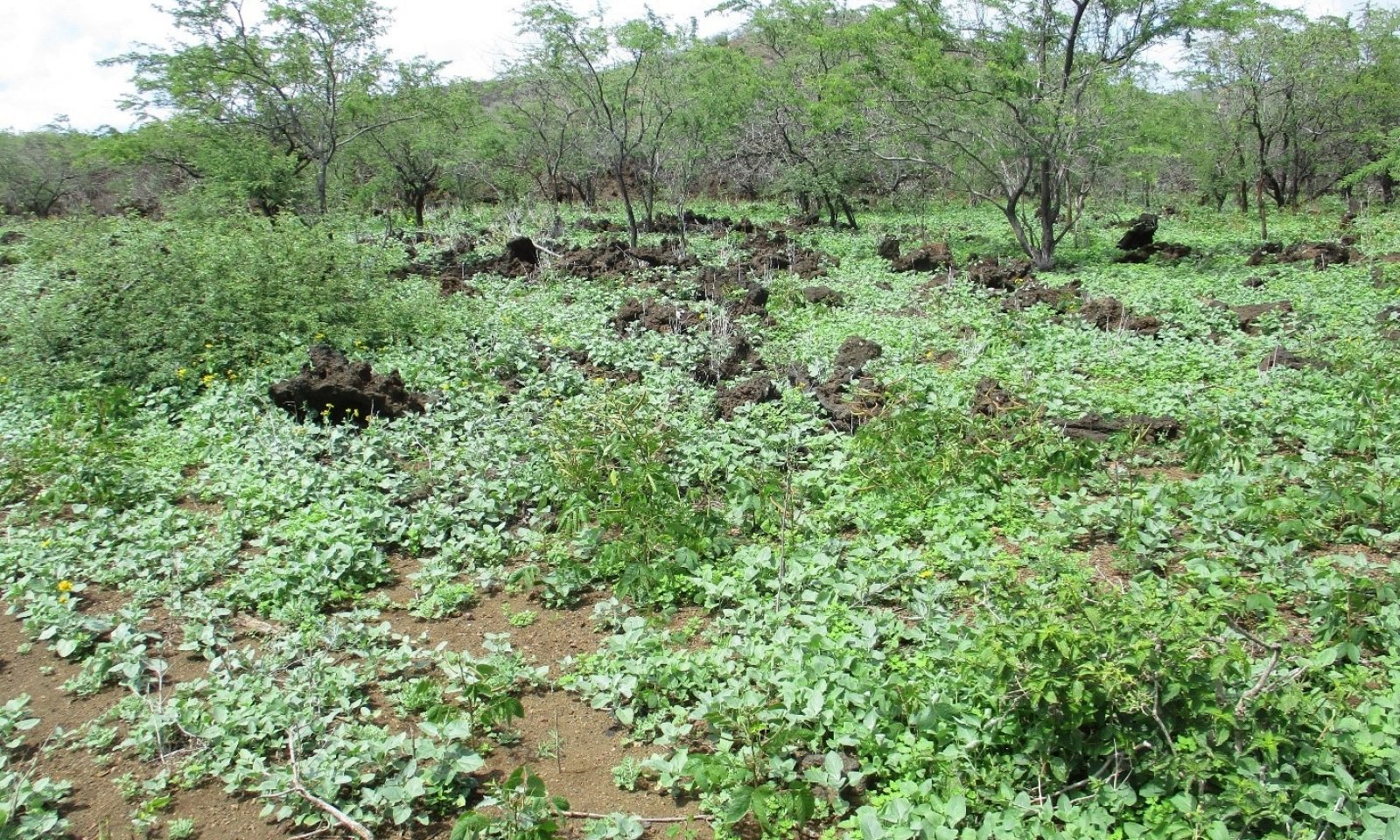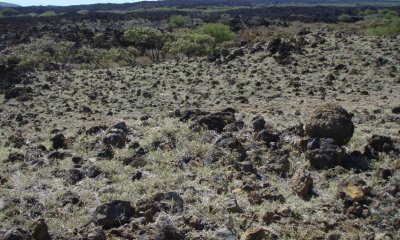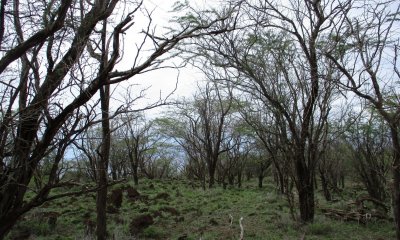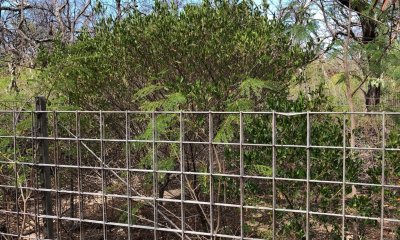
Rocky Volcanic Ash Savanna Kiawe/buffelgrass (Prosopis pallida/Pennisetum ciliare)
Scenario model
Current ecosystem state
Select a state
Management practices/drivers
Select a transition or restoration pathway
-
Transition T1A
Succession
More details
State 1 Reference transitions to State 2 Kiawe Invaded in the absence of disturbance such as fire or brush management. -
Restoration pathway R1A
Restoration
More details
State 1 Reference transitions and is maintained to State 3 Native Savanna with significant management inputs. The site must be fenced to exclude all domestic and feral ungulates. A firebreak must be established and maintained around the fence line by grazing or mowing. Buffelgrass and other non-native vegetation must be killed, followed by plantings of native trees, shrubs, and vines. Supplemental irrigation may be necessary in the early stages of restoration. -
Transition T1B
Long-Term Systematic Herbivory
More details
State 1 Reference transitions and is maintained to State 4 Toxic/Unpalatable Forb primarily by constant heavy browsing and grazing by feral goats and on Maui, deer. -
Restoration pathway R2A
Land Clearing, Fire
More details
State 2 Kiawe Invaded transitions to State 1 Reference when kiawe are cleared by fire, herbicidal application, or mechanical means. While wildfire will kill kiawe, prescribed burning is typically not done in Hawaii due to the level of risk to relict native ecosystems and enjoined or embedded development. Once cleared, additional brush management strategies to avoid introduction of invasive shrubs (lantana, klu, koa-haole, etc) will be required and prescribed grazing strategies allowing for sufficient rest of perennial grasses and forbs will be needed. -
Transition T3A
Land Clearing by Fire, Ungulate Disturbance, or Mechanical Means
More details
State 3 Native Savanna transitions to State 1 Reference when it is cleared by fire, long-term ungulate disturbance, or mechanical means. While wildfire will clear most native vegetation, prescribed burning is typically not done in Hawaii due to the level of risk to enjoined or embedded relict native ecosystems and development. Desired perennial grass and forbs (typically naturalized forage species) are then re-established. -
Restoration pathway R4A
Reclamation
More details
State 4 Toxic/Unpalatable Forb transitions to State 1 Reference with significant management inputs. Management and significant reduction in the numbers of the feral animals in the area is necessary. This may involve fencing, trapping, and other herd reduction methods. The soil seed bank will probably bring back a variety of plant species in a favorable weather year but seeding of desired forages or native plants is recommended, along with continuous weed and brush control as necessary. Sites that are severely eroded may require additional management inputs and conservation practices. -
No transition or restoration pathway between the selected states has been described
Target ecosystem state
Select a state
State 1
Reference State




Description
This state consists of three community phases dominated by introduced grasses with less than 25 percent canopy cover of introduced trees. The transition from one plant community within the state to another is often related to the dynamics of fire, grazing, and brush management.
State 1 transitions to State 2 (Kiawe-Invaded) with lack of brush management practices or absence of wildfire.
State 1 transitions to State 4 (Toxic/Unpalatable Forb) with extreme overgrazing and browsing by goats and/or deer.
Characteristics and indicators
The dominant grass species is buffelgrass (Pennisetum ciliare). Kiawe (Prosopis pallida) is the most abundant naturalized tree species. Because kiawe is a phreatophyte, access to soil moisture or groundwater can considerably affect this plant’s abundance.
Resilience management
With lack of brush control or absence of fire, this state will transition to State 2 Kiawe-Invaded, in which production and cover of buffelgrass and other forages is reduced by shade and possibly competition from kiawe. Accumulation of fine (grass) fuels under light or no grazing pressure increases the likelihood of fire. This can produce an open grassland with little tree overstory wherein more frequent fire is perpetuated by rapid revegetation of highly fire-resilient, non-native grass species.
Non-native savannas in Hawaii that are not grazed present fire protection challenges to embedded or adjoining developed areas and increase the rate of erosion and sediment transport to the ocean. With longer-term overgrazing and browsing by goats and, on Maui, deer, nearly all forages are removed, leading to a transition to State 4 Toxic/unpalatable Forb State.
With continuous heavy grazing, particularly by cattle, buffelgrass will decrease. Koa haole and bush indigo (Indigofera suffruticosa) also will decrease under heavy grazing pressure. Increasers, depending on location, include bluestems (Bothriochloa spp.), Natal redtop or rose Natal grass (Melinis repens), swollen fingergrass (Chloris barbata), feather fingergrass (Chloris virgata) and weedy forbs. With severe deterioration, shrubby species such as lantana (Lantana camara) and apple of Sodom (Solanum linnaeaum) increase. Shortgrasses such as Bermudagrass (Cynodon dactylon), low-vigor buffelgrass, and weedy annual forbs become more abundant, as well as lesser amounts of pricklypear cactus or Barbary fig (Opuntia ficus-indica, mostly in gulches). Pricklypear cactus abundance has been limited by an introduced biocontrol insect.
Native aalii (Dodonaea viscosa) can increase with exclusion of livestock grazing or lack of fire. The forage potential of the site is reduced by the increased canopy cover of this native shrub.
Submodel
Description
State 2 Kiawe Invaded is characterized by dense kiawe canopy covers over 25%. Scattered grasses and forbs may be in the understory. This state consists of one community phase.
Characteristics and indicators
It occurs when brush management has not been practiced or if wildfire has not occurred for a long time, allowing kiawe to increase in density and stature to a level at which understory production is significantly reduced.
Resilience management
To cross a threshold back to State 1, a fire return interval <15 years is needed, and likely additional brush management strategies to avoid proliferation of invasive shrubs (lantana, klu, koa-haole, etc). Prescribed grazing strategies allowing for sufficient rest of herbaceous forages will be needed as well. Conversion from State 2 back to any community in State 1 will require extensive labor, time and money.
Description
This state consists of one community phase. Intact examples of this community no longer exist. This description is compiled from field observations of remnant vegetation, isolated plants on disturbed sites, a similar ecological site on the Island of Hawaii, and historical accounts.
Submodel
State 4
Toxic/Unpalatable Forb State



Description
State 4 Toxic/Unpalatable Forb consists of one community phase vegetated mostly with toxic or otherwise highly unpalatable plants; kiawe may be present in varying amounts. It is caused and maintained primarily by constant heavy browsing and grazing by feral goats and/or deer.
Characteristics and indicators
Where there is no kiawe canopy (Big Island), the site goes to bare ground and starts to erode. Where there is kiawe to create a shaded microclimate, toxic forbs have replaced all acceptable forages. Many of these forbs behave more like annuals and will die during prolonged dry conditions. These sites are very prone to serious soil erosion.
Resilience management
Management and significant reduction in the numbers of the feral animals in the area is necessary. This may involve fencing, trapping, and other herd reduction methods. The soil seed bank will probably bring back a variety of plant species in a favorable weather year but seeding of desired forages or native plants is recommended, along with continuous weed and brush control as necessary. Sites that are severely eroded may require additional management inputs and conservation practices.
Submodel
Mechanism
State 1 Reference transitions to State 2 Kiawe Invaded in the absence of disturbance such as fire or brush management.
Kiawe seedlings are usually found associated with animal droppings and are intolerant of shade. The continuous Buffelgrass cover typical of State 1 (Reference), Phase 1.1 can limit kiawe establishment. The dominance of perennial short grasses and increasing bare ground typified in State 1, Phase 1.2 and Phase 1.3 can provide kiawe seedlings an advantage to establish. Seedling survival depends primarily on sufficient rainfall during 4 to 6 weeks after germination. As recruitment and dispersal progress, kiawe begins to out compete perennial grasses for water, soil nutrients, and light. Access to water is the greatest limiting factor to plant survival in this site. As a phreatophyte kiawe thrives where it has access to both soil moisture and ground water. It develops an overstory canopy cover that reduces solar radiation penetration to the soil surface. Kiawe is also implicated as a potential cause of changes in local hydrology and mineral cycling due to it’s efficient water harvesting capability and nitrogen fixation (Dudley, 2014).
Constraints to recovery
Conversion from State 2 back to any community in State 1 will require extensive labor, time, and money.
Controlling Kiawe by mechanical means can cause soil disturbance impacts. Kiawe and weedy species from the seed bank may flourish after Kiawe trees are removed. This is exacerbated in areas where the soils are disturbed.
Relevant conservation practices
| Practice | External resources |
|---|---|
|
Brush Management |
|
|
Firebreak |
|
|
Land Clearing |
|
|
Prescribed Grazing |
|
|
Fuel Break |
|
|
Grazing Management Plan |
Mechanism
State 1 Reference transitions and is maintained to State 3 Native Savanna with significant management inputs. The site must be fenced to exclude all domestic and feral ungulates. A firebreak must be established and maintained around the fence line by grazing or mowing. Buffelgrass and other non-native vegetation must be killed, followed by plantings of native trees, shrubs, and vines. Supplemental irrigation may be necessary in the early stages of restoration.
Expected Effects: Increased Litter Accumulation, Increased Nutrient Availability, Increased Water Infiltration, Reduced Solar radiation, Increased Soil Moisture, Genetic Conservation,
Enhanced Wildlife Habitat including Improved Pollinator Forage and Nesting.
Context dependence
Conversion from any community in State 1 Reference to State 3 Native Savanna will require extensive and sustained labor, time, and money.
Relevant conservation practices
| Practice | External resources |
|---|---|
|
Fence |
|
|
Irrigation System, Microirrigation |
|
|
Integrated Pest Management (IPM) |
|
|
Tree/Shrub Establishment |
|
|
Restoration and Management of Rare and Declining Habitats |
|
|
Native Plant Community Restoration and Management |
|
|
Fuel Break |
|
|
Pathogen Management |
|
|
Conservation Plan Implementation |
|
|
Monitoring and Evaluation |
|
|
Establish pollinator and/or beneficial insect habitat |
Mechanism
State 1 Reference transitions and is maintained to State 4 Toxic/Unpalatable Forb primarily by constant heavy browsing and grazing by feral goats and on Maui, deer, such that nearly all perennial grass and forb (forages) are removed.
Large patches of mortality within the grass and forb functional groups are becoming common on the landscape. In areas where ground cover has persisted, the cover and vigor of perennial grass and forbs have become greatly reduced. Litter accumulation is greatly reduced to non-existent, and bare ground patches are large and frequently connected. This results in the creation of large barren areas suitable for toxic forbs to colonize. Access to water is the greatest limiting factor to plant survival in this site. Water infiltration is greatly reduced in areas of bare ground and/or reduced perennial grass cover. Solar radiation penetration to the soil surface increases significantly in areas of bare ground and/or reduced perennial grass cover. These changes create a competitive advantage which favors the establishment and further spread of toxic/unpalatable forbs as well as invasive shrub species.
Constraints to recovery
Many of these forbs behave more like annuals and will die during prolonged dry conditions. As such, these sites are very prone to serious soil erosion by water and wind as indicated by: water flow paths, pedestalled plants with roots exposed, and/or in extreme situations, the mineral horizons become exposed.
Relevant conservation practices
| Practice | External resources |
|---|---|
|
Brush Management |
|
|
Fence |
|
|
Land Reclamation, Landslide Treatment |
|
|
Prescribed Grazing |
|
|
Integrated Pest Management (IPM) |
|
|
Planned Grazing System |
|
|
Prescribed Grazing |
|
|
Invasive Plant Species Control |
|
|
Biological suppression and other non-chemical techniques to manage herbaceous weeds invasive species |
Mechanism
State 2 Kiawe Invaded transitions to State 1 Reference when kiawe are cleared by fire, herbicidal application, or mechanical means. While wildfire will kill kiawe, prescribed burning is typically not done in Hawaii due to the level of risk to relict native ecosystems and enjoined or embedded development. Once cleared, additional brush management strategies to avoid introduction of invasive shrubs (lantana, klu, koa-haole, etc) will be required and prescribed grazing strategies allowing for sufficient rest of perennial grasses and forbs will be needed.
Fire: The effects of fire impacts on plant populations and habitat quality depend on fire severity (high, medium low), habitat type burned, species biology, timing of burning (wet or dry), plant phenology (stage of plant development when burned) and site conditions (e.g., topography, moisture (Brown et al 2000). Fire will kill Kiawe and will also reduce its postfire recruitment through direct mortality of the seeds on or near the surface (Gallaher and Merlin 2010, Smith and Tunison 1992). However, vigorous regeneration from the seed bank can occur in areas of high ground disturbance. Invasive, fire-prone grasses such as buffelgrass encourage wildfire because they ignite and spread wildfire quickly (HWMO 2019). Non-native savannas in Hawaii that are not grazed create hazardous fuels which result in wildfire frequency and increased increased rates of erosion and sediment transport to the ocean. These alien grasses usually recover to pre-burn levels and often intensify after fire. Fire thus promotes conditions that increase fire frequency and size by increasing the continuity and/or fuel loadings of alien grasses (Smith and Tunison 1992). Many native species, for example, wiliwili and lama, remaining in this ecological are not adapted to fire. For this reason, relictual native woodlands are now threatened by fine fuel loading from alien grasses.
Mechanical Control: Some mechanical techniques that have been employed successfully include blade plowing, chain pulling, bulldozing, and stick raking (Gallaher and Merlin 2010). These methods can create high levels of ground disturbance and soil compaction.
Herbicidal Control. Basal bark and cutstump application of have been employed in Hawaii (Pers Obs 2021). Although this method works well for isolated individuals, it is both cost- and time-prohibitive for large areas with dense stands.
Once cleared, perennial grasses and forbs reassume dominance where they have regained access to soil moisture, nutrients and light.
Context dependence
Conversion from State 2 back to any community in State 1 will require extensive labor, time, and money.
Relevant conservation practices
| Practice | External resources |
|---|---|
|
Brush Management |
|
|
Land Clearing |
|
|
Prescribed Grazing |
|
|
Integrated Pest Management (IPM) |
|
|
Invasive Plant Species Control |
|
|
Grazing Management Plan |
Mechanism
State 3 Native Savanna transitions to State 1 Reference when it is cleared by fire, long-term ungulate disturbance, or mechanical means. While wildfire will clear most native vegetation, prescribed burning is typically not done in Hawaii due to the level of risk to enjoined or embedded relict native ecosystems and development. Desired perennial grass and forbs (typically naturalized forage species) are then re-established.
These disturbances initiate change by affecting the composition, structure, and pattern of vegetation on the landscape (Brown et al 2000 re fire). They affect plants directly, by injury and mortality, and indirectly, by changing resource availability including light, nutrients, pollinators, and mutually beneficial microorganisms such as mycorrhizae, translating into vegetation changes (clearing) at the plant, population, and community level.
Fire Effects: Fires of all intensities, timing, and causes are harmful to most native ecosystems in Hawai`i (Smith and Tunison 1992). Alien species, particularly grasses such as buffelgrass, recover rapidly and fill in the spaces left by native plants, which recover more
slowly, if at all. In Hawaii, fires establish a destructive cycle by increasing fuel loadings of flammable alien grasses, which in turn increase fire frequency and fire size. Subsequent burns further inhibit the reestablishment of native trees species. Some native species easily killed by fire include wiliwili, lama, and akia (Smith and Tunison 1992). Native species tolerant (aerial portions of all native plant species are readily killed by fire, but some resprout or recover from seed) to a very low frequency of fire, recover to some degree after burns, but typically to populations far less than those found in pre-burn conditions because they typically must compete with fire-stimulated alien grasses. Naio (Myoporum sandwicense) resprouts after fire as long as the fire is not too intense. Regrowth is slow and the original canopy cover takes over five years to regenerate. The seeds of `a`ali`i (Dodonaea viscosa) germinate readily after fire, but it is not known if they are fire-stimulated. `A`ali`i may reach higher densities after fire than before. Most native bunchgrasses recover rapidly after burning. Pili grass resprouts readily with a significant increase in cover following low-intensity fire.
Effects of Continued, Long-Term Systematic Herbivory
With continued, long-term systematic herbivory and browsing by goats and, on Maui, deer, nearly all native grass and forbs (forages) and regenerating shrub and tree seedlings are removed allowing buffelgrass to resume dominance.
Constraints to recovery
Prescribed burning is not, on the whole, an effective management tool in Hawai`i, although it may have potential limited management and research value (Smith and Tunison 1992). Moreover, the intensification of fire-prone alien grasses following fire assures the increased incidence of fire, thereby establishing a self-perpetuating alien grass/fire cycle. The effects of fire argue strongly that all agencies responsible for the management of fire in natural areas in Hawai`i should aggressively suppress all fires, whether caused by lava flows, lightning, or humans.
Relevant conservation practices
| Practice | External resources |
|---|---|
|
Brush Management |
|
|
Prescribed Grazing |
|
|
Range Planting |
|
|
Integrated Pest Management (IPM) |
|
|
Prescribed Grazing |
|
|
Invasive Plant Species Control |
|
|
Grazing Management Plan - Written |
Mechanism
State 4 Toxic/Unpalatable Forb transitions to State 1 Reference with significant management inputs.
Management and significant reduction in the numbers of the feral animals in the area is necessary. This may involve fencing, trapping, and other herd reduction methods. The soil seed bank will probably bring back a variety of plant species in a favorable weather year but seeding of desired forages or native plants is recommended, along with continuous weed and brush control as necessary. Sites that are severely eroded may require additional management inputs and conservation practices.
Expected Effects: Rest from Continued Disturbance, Soil Stabilization, Reduced Soil Erosion (wind and water), Recruitment and Dispersal of Perennial Grasses, Increased Perennial Grass Cover, Reduced Toxic Forb, Decreased Solar Radiation to Soil Surface, Soil Stabilization, and Increased Water Infiltration.
Context dependence
Adequate spring and summer rain events help accelerate vegetative growth, reproduction, and reestablishment of perennial grasses including buffelgrass and pitted beardgrass.
Relevant conservation practices
| Practice | External resources |
|---|---|
|
Brush Management |
|
|
Fence |
|
|
Land Reclamation, Landslide Treatment |
|
|
Range Planting |
|
|
Planned Grazing System |
|
|
Prescribed Grazing |
|
|
Invasive Plant Species Control |
Model keys
Briefcase
Add ecological sites and Major Land Resource Areas to your briefcase by clicking on the briefcase (![]() ) icon wherever it occurs. Drag and drop items to reorder. Cookies are used to store briefcase items between browsing sessions. Because of this, the number of items that can be added to your briefcase is limited, and briefcase items added on one device and browser cannot be accessed from another device or browser. Users who do not wish to place cookies on their devices should not use the briefcase tool. Briefcase cookies serve no other purpose than described here and are deleted whenever browsing history is cleared.
) icon wherever it occurs. Drag and drop items to reorder. Cookies are used to store briefcase items between browsing sessions. Because of this, the number of items that can be added to your briefcase is limited, and briefcase items added on one device and browser cannot be accessed from another device or browser. Users who do not wish to place cookies on their devices should not use the briefcase tool. Briefcase cookies serve no other purpose than described here and are deleted whenever browsing history is cleared.
Ecological sites
Major Land Resource Areas
The Ecosystem Dynamics Interpretive Tool is an information system framework developed by the USDA-ARS Jornada Experimental Range, USDA Natural Resources Conservation Service, and New Mexico State University.





